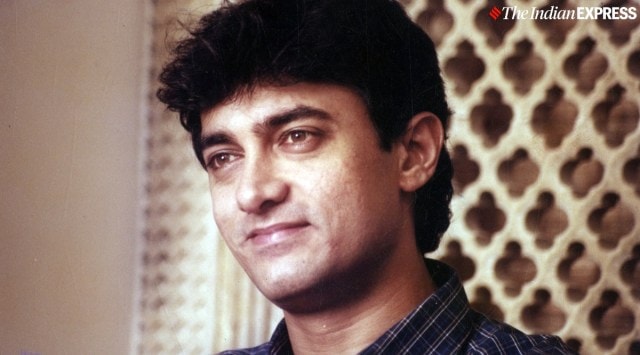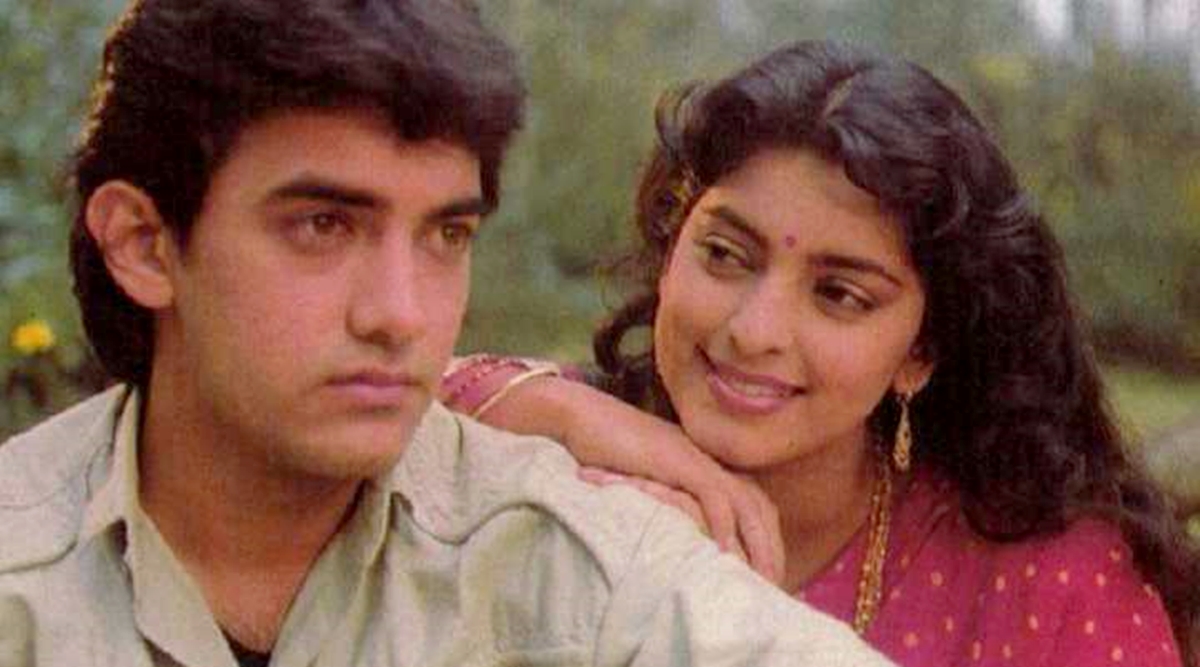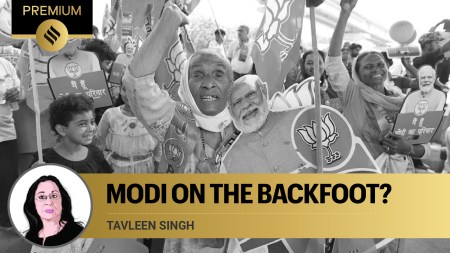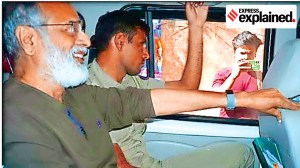- India
- International
The real Aamir Khan: How Bollywood’s Mr Perfectionist remained relevant for 35 years in ever-changing India
As Aamir Khan completes 35 years in the Hindi film industry, here's looking at how the superstar is still relevant all these years later.
 Aamir Khan made his film debut 35 years ago. (Photo: Express Archives)
Aamir Khan made his film debut 35 years ago. (Photo: Express Archives) Two diametrically opposite images playing out on national TV this week brought our focus back to one face, that of Aamir Khan, a star we have loved, admired, and reviled for the past three decades and counting. The first is an ad in which he plays a version of himself, in which the joke is on him and his last outing, the 2022 Laal Singh Chaddha, a critical and commercial disaster. The other is a frontline celebrity being exhibited at an official function where he is heard talking up Mann Ki Baat, a radio programme he says has changed lives in India.
The former, a cheeky, self-aware persona which declares that while the public barometer towards him may vary, his place in the pantheon of stars is assured. The latter, in clear compliance with the times we are living in, where his stardom is required to align with the diktats of those who rule.
Who is the real Aamir Khan? And why does he matter?
When he waltzed into our hearts thirty-five years back on this day, when his blockbuster ‘Qayamat Se Qayamat Tak’ released, making him and co-star Juhi Chawla overnight stars, we had no inkling of his longevity. Neither did he. He was a child of the industry, who at one point was looking to veer towards serious sports rather than the movies, but returned to the fold to see where it took him. Once he zoomed straight to the top, and liked the view from there, there was no looking back.
 Aamir Khan and Juhi Chawla in Qayamat Se Qayamat Tak.
Aamir Khan and Juhi Chawla in Qayamat Se Qayamat Tak.
He took his time proving that QSQT, the first Hindi film whose initials carried the weight of an iconic film, produced by his uncle Nasir Hussain, and directed by cousin Mansoor Khan, was no flash in the pan. Within a short span, buoyed by luck and determination, he made it to that enviable place where hits and flops do not shake stardom. It may acquire dents, and require occasional paint jobs, but it stays intact.

Quite simply, Aamir changed the face of the Hindi film industry by dint of being who he was, his choice of films, his method of working slowly, steadily and surely, and his insistence on doing one-film-at-a-time, which positively impacted the chaotic ricocheting from one set to another which used to be a norm before he started doing things differently.
He was not amongst those performers who merely showed up on set, delivered their lines, and left after pack-up. From very early on in his career, it was clear that he wanted to be involved with every aspect of filmmaking, from the behind-the-scenes tech-specs to how it would roll out after the film was complete. Everything should be just right was his mantra, and he went the distance this trait required him to, happy to be known as Mr Perfectionist as opposed to Mr Popular. Mahesh Bhatt successfully created a rom com hero out of him, but the duo famously fell out during the shooting of ‘Ghulam’, a Vishesh Films production, which Vikram Bhatt went on to helm. Aamir’s equally infamous fallout with Ram Gopal Varma, after the super-hit ‘Rangeela’, became fodder for gossip rags : they never worked together again. Half-way through the making of ‘Taare Zameen Par’, director Amol Gupte was removed, and Aamir took his place : whatever the stories behind the removal, and there were many, the finished product was seamless, proving that the actor could direct too.
But like superstars who survive the egregious likes and dislikes of fickle viewers, cementing their position with each passing year, Aamir is more than just his compendium of roles, some of them belonging to path-breaking films over the years, and in the way he changed the functioning of the industry.
By standing up for his beliefs, remaining steadfast in the face of vile personal attacks, Aamir, like Shah Rukh, has stayed faithful to the idea of what a star should be in this disturbing era of increasing polarities: a star whose appeal cuts across class, creed, religion, whose vulnerabilities are not hidden, whose faults are on display, but whom we are ready to forgive, and laugh and cry with, given half a chance.
QSQT became a superhit which spawned a superstar, and created a new ‘jodi’, something Hindi movies were always on the look-out for. It did so not just because of its star-crossed romance and its foot-tapping music: it did so because it caught the zeitgeist. In remarkably short order, QSQT became a cultural short-form which denoted young love, staying on our radar all these years. There are parts which feel dated if you watch it now, but it still gives you the feels. Everyone loves a lover, and always will.
Despite a few interesting flourishes, the 80s was a tough decade for Hindi films, reeling under the onslaught of the assembly line products made at the cheap for frontbenchers. Mansoor Khan was clear that he wanted to make a film which would reflect its times, and wasn’t entirely happy about the ‘thakurs’ and their traditional ways which had to find space in the film. He made up for the old-style, old-school elements by creating mint-fresh young lovers who looked like any other ‘boy and girl’. The combination of Aamir in his black trousers, white shirt, accompanied by a guitar he manages not to play while launching into the evergreen ‘Papa kehte hain bada naam karega’, and Juhi in her everygirl plaits and trademark ‘chulbuli’ delivery, was an irresistible charm offensive, and we fell headlong under their spell.
QSQT redefined young love. Most importantly, it redefined the notion of a hero. Heroes could safely be regular young men, not the muscle-bound invincibles, fending off scores of baddies in one fell swoop (later, Aamir would do versions of this hero, without a shred of irony: remember ‘Ghajini’ where he scythes through a phalanx of baddies?). Plots could revolve around more regular elements, rather than heavy-on-glycerine strands.
Aamir’s heroes were the first movers in a Bollywood trying to carve relatable characters for a post-liberalised India: the rape-and-revenge ‘Raakh’, which he shot before QSQT but which released right after, directed by Aditya Bhattacharya, bombed: if the film had worked, it would have changed trajectories dramatically. But he dialled back from that misfire to scripts which gave him ‘young Indians on the move’ roles– ‘Dil Hai Ki Manta Nahin’, ‘Jo Jeeta Woh Sikandar’ (in which Farah Khan gave us the sort of fresh, contemporary choreography we had never seen before in Bollywood), ‘Hum Hain Rahi Pyaar Ke’– where he and the film are light on their feet, fulfilling the audience demands of ‘halka-phulka’ entertainment.
After that phase, almost every film he did set a benchmark. Take ‘Rangeela’, in which Aamir aced the tapori act, and wore a screaming yellow shirt-and-pants combo never bettered. Or ‘Ghulam’, where he sang ‘Aati Kya Khandala’, a suggestive leer in his voice? John Mathew Mathan’s spiffy spy saga ‘Sarfarosh’ in which the ‘hero ki entry’ happened, most unusually, with Aamir’s back to the camera? The Oscar-nominated ‘Lagaan’, in which his friend and director Ashutosh Gowariker’s sets were the first to introduce sync-sound. Farhan Akhtar’s debut ‘Dil Chahta Hai’, which changed forever the depiction of wealth in Bollywood. His production of ‘Delhi Belly’ which bravely went where no Bollywood film had in its portrayal of young lust. ‘Ghajini’, directed by A R Murugadoss, rekindled interest in South masala remakes, and crafted the term ‘the hundred crore club’: the promotions and marketing of the film had an Aamir imprint, something no other star had done before.
The creation of Aamir as a national Indian icon whose voice would be taken seriously whichever platform he spoke from began in right earnest after ‘Lagaan’, in which his Bhuvan smote the British overlords over the boundary for a six. Rakesh Omprakash Mehra’s ‘Rang De Basanti’, which had Aamir play a senior student got the brand of candle-lit bleeding-hearts liberal patriotism into the movies which led to, yes, change on the ground. Rajkumar Hirani’s ‘3 Idiots’, in which Aamir successfully pulled off a twenty-something look at forty-something, opened up foreign markets, especially China, and zoomed right to the top of the ‘most successful Indian films’ bracket. The film was not only a financial success. It made a strong statement against unbearable academic-and-peer pressure, something that can cause young lives to end, leading to many conversations on the subject.
Hirani’s ‘PK’ gave Aamir a chance to play a wide-eyed alien with a sharp sense of fairplay. And Nitesh Tiwari’s ‘Dangal’ in which Aamir plays his age and the father of four girls, is arguably the most successful sports film Bollywood has produced, and whose tagline ‘mhaari choriyaan choron se kum hain’ has never lost resonance, especially today when we see the besieged wrestlers from Haryana asking for justice.
 Aamir Khan in a still from Dangal.
Aamir Khan in a still from Dangal.
These films helped create Citizen Aamir, someone solid, utterly reliable, privileging brain over brawn, speaking straight from the heart, holding dear the well-being of all Indians, the characteristics which formed the heart of his talk-show, ‘Satyameva Jayate’. The hour-long Sunday special whose fleetingly sanctimonious, do-gooding air was combated by Aamir-the-caring-host persona, was a huge, well-deserved success. Just like the Aamir Khan directed ‘Taare Zameen Par’, which brought conversations around dyslexia and those who learn differently into the open, ‘Satyameva Jayate’ shone a light on socially combustible topics, bringing various stakeholders face-to-face. It was an example of star-power harnessed for social causes done right.
Unlike the two other superstar Khans, Salman and SRK, who were recently seen ruing their about-to-be-senior-citizen-status in a hilarious Pathaan outtake, Aamir has appeared to be in no danger of aging out, as he has managed to look preternaturally young. No one knows how this Peter Pan ever-youthful appearance is acquired and maintained (do these stars live in an oxygen bubble?), but sometimes it can back-fire. His Laal Singh Chaddha was a failure, no just of the character, but of the star who suddenly appeared to be out of sync with the times.
That a star who had his first hit thirty five years ago, is still in the running, is remarkable. That a star who happens to be Muslim, and whose religious identity has been under attack, is still considered popular enough to be brought on the current regime’s track is even more so. Aamir Khan’s stardom has been acquired over the years, maintained painstakingly through hits and pits (who can forget ‘Mangal Pandey’ and that beyond terrible ‘Thugs Of Hindostan’, among others), and has the potential to last. Because he’s that kind of star.
All these years, Aamir has been a changemaker, a tastemaker. The question now is, can he shape-shift enough, keeping his core integrity to the fore, and remain relevant to new India?
I’m betting on him.
Click for more updates and latest Bollywood news along with Entertainment updates. Also get latest news and top headlines from India and around the world at The Indian Express.
Best of Express
May 16: Latest News
- 01
- 02
- 03
- 04
- 05








































